#sql course for beginners
Explore tagged Tumblr posts
Text
SQL for Beginners: Your Gateway to Data Management

Have you ever wondered how websites recall user information, businesses monitor sales patterns, or applications retrieve your login information in seconds? The answer lies in Learning SQL for Beginners, the basic language that powers databases globally. Whether you are an aspiring data analyst, a software developer, or just a database enthusiast, learning SQL can be a game-changer.
What is SQL?
SQL, or Structured Query Language, is a programming language used to communicate with and manipulate databases. SQL is a fundamental part of database management systems since it enables users to perform a number of operations on data in relational databases. SQL databases exist in various types, such as MySQL, PostgreSQL, SQL Server, and SQLite, with differences in features and functionality. These databases offer users the functionality to create, manage, and query data efficiently.
Why Is SQL Essential?
The following are the reasons why understanding SQL is crucial:
Creating New Databases, Tables, and Views: SQL allows you to create and organize data effectively by creating new databases, tables, and views. This first step organizes your data, making it easier to manage and retrieve information whenever you want.
Inserting Records in a Database: In case you have data to store, SQL combines statements like INSERT that allow you to add new records to your tables. This helps in making your database up-to-date with new data.
Updating Records in a Database: SQL provides the ability to update existing records with commands like UPDATE so that your database remains accurate and helpful over time.
Deleting Records from a Database: Sometimes, certain records must be removed in order to keep a neat database. SQL’s DELETE command provides an efficient way of removing unwanted entries from your tables, thereby enhancing data integrity.
Retrieving Data from a Database: The biggest strength of SQL lies in its ability to retrieve data precisely. With the SELECT statement, you can request specific details from your database to promote analysis and reporting.
Applications of SQL
SQL is not just a technical skill but has a wide range of applications in various fields. Below is how SQL is utilized in the real world:
Data Analysis: Organizations utilize SQL to analyze large data, pull out information, and generate reports. Analysts and data scientists can use SQL to query data efficiently, enabling well-informed decision-making that results in business growth.
Web Development: SQL is used by many web applications as a means of communicating with back-end databases. From storing user information to managing content, SQL helps developers make their applications operate smoothly and retrieve data quickly whenever needed.
Customer Relationship Management (CRM): SQL is utilized in CRM applications to store and maintain customer data, interactions, and purchase history. Using SQL, organizations are able to analyze customer behavior, which helps in developing improved relationships.
Healthcare & Medical Records: SQL databases find application in the healthcare sector through hospitals and clinics to maintain patient records, track prescriptions, and manage appointments securely and efficiently. This helps in handling sensitive information in a proper way while enabling healthcare professionals to access important information quickly.
E-commerce & Retail: SQL powers online shopping sites with product inventories, order processing from customers, and personalized recommendations based on user behavior. Such capabilities allow e-commerce businesses to enhance customer experiences and ultimately increase sales.
Explore UniAthena’s SQL Beginner to Advanced Course
This SQL course provides you with an overview of database fundamentals like data, fields, records, and databases. It also covers basic DBMS and RDBMS concepts and the key role of SQL in database management, showcasing the significant role played by it in database management efficiently.
You will also learn about SQL constraints, aggregate functions, join types, stored procedures, views, and indexes. Through the blend of theory and practice, you will become skilled in using the application of functions with queries, database management, and effective handling and manipulation of data with the diverse use of SQL elements.
With a learning duration of just 1–2 weeks, this self-paced course can fit into your schedule. And upon completion, you will get yourself a chance to gain a Blockchain-verified certification, which adds credibility to your skills. If you are looking for the Best Free Online Short Course, this is your chance to upskill. Enroll now.
#learning sql for beginners#sql intermediate course#sql beginner to advanced#Online free learning#Best free Online short courses
0 notes
Text
Learn SQL Easily with Takeoff Upskill and Build Your Data Skills
SQL (Structured Query Language) is one of the most important skills for anyone working with data. At Takeoff Upskill, we offer a comprehensive SQL course that makes learning this valuable skill easy and accessible. Whether you are a beginner or someone looking to enhance your database knowledge, this course is designed to meet your needs.

Our SQL course starts with the basics, such as understanding databases, tables, and data types. You will learn how to create, read, update, and delete data using SQL commands. The course also covers advanced topics like joining multiple tables, writing complex queries, and optimizing database performance. These skills are essential for roles like data analyst, software developer, and database administrator.
The training at Takeoff Upskill is practical and hands-on. We provide real-world examples and exercises that help you understand how SQL is used in businesses. By the end of the course, you will be confident in writing queries, managing data, and solving database challenges. Our experienced trainers guide you every step of the way, ensuring you gain a strong foundation.
#SQL course#SQL training#data management#Takeoff Upskill#SQL for beginners#learn SQL#database queries#SQL skills
0 notes
Text
Master SQL Course with Takeoffupskill
Introduction:
Welcome to Takeoffupskill's comprehensive SQL Course, designed to empower you with the essential skills needed to harness the power of databases. Whether you're a beginner looking to grasp the basics or an experienced professional aiming to refine your SQL proficiency, our course offers a structured learning path tailored to meet your needs. SQL (Structured Query Language) is the cornerstone of database management and is crucial for anyone involved in handling data, from analysts to developers.

In this course, we start with the basics: understanding database structures, learning SQL syntax, and executing simple queries. As you progress, you will Look into complex topics such as data manipulation, joins, subqueries, and database optimization strategies. Each module is crafted with practical examples and hands-on exercises to ensure you not only understand the theory but also gain the confidence to apply SQL in real-world scenarios.
Our instructors are seasoned professionals with extensive industry experience, committed to providing clear explanations and practical insights throughout the course. You'll benefit from their expertise as they guide you through challenging concepts and demonstrate best practices for efficient database management.
By the end of this course, you will possess a solid foundation in SQL, enabling you to write powerful queries, extract valuable insights from data, and contribute effectively to your organization's data-driven initiatives. Whether your goal is to advance your career, enhance your analytical skills, or simply gain a deeper understanding of databases, the Takeoffupskill SQL course equips you with the knowledge and proficiency to excel in today's data-driven world.
Conclusion:
Investing in your SQL skills with Takeoffupskill not only opens doors to new career opportunities but also empowers you to leverage data effectively in any professional setting. With hands-on practice, expert guidance, and a structured curriculum, our SQL Course ensures that you not only learn SQL but also master it. Join us today and take the first step towards becoming a proficient SQL practitioner. Whether you're starting fresh or refining existing skills, Takeoffupskill is here to support your journey toward SQL mastery.
0 notes
Text

data analyst training courses | online certification courses
With our online Data Analyst Certification Course, you may advance your career to new heights. Develop your abilities to succeed in the data-driven world.
data analyst online course for beginners , data analyst certification course , data analyst training courses | online certification courses , data analyst course for beginners , data analyst training | data analyst course
#data analyst online course for beginners#data analyst certification course#data analyst training courses | online certification courses#data analyst course for beginners#data analyst training | data analyst course#data analytics#power bi certification#power bi certification cost#sql#power bi course fees#power bi#power bi course#power bi online training#msbi#education
1 note
·
View note
Text
SQL Fundamentals #1: SQL Data Definition
Last year in college , I had the opportunity to dive deep into SQL. The course was made even more exciting by an amazing instructor . Fast forward to today, and I regularly use SQL in my backend development work with PHP. Today, I felt the need to refresh my SQL knowledge a bit, and that's why I've put together three posts aimed at helping beginners grasp the fundamentals of SQL.
Understanding Relational Databases
Let's Begin with the Basics: What Is a Database?
Simply put, a database is like a digital warehouse where you store large amounts of data. When you work on projects that involve data, you need a place to keep that data organized and accessible, and that's where databases come into play.
Exploring Different Types of Databases
When it comes to databases, there are two primary types to consider: relational and non-relational.
Relational Databases: Structured Like Tables
Think of a relational database as a collection of neatly organized tables, somewhat like rows and columns in an Excel spreadsheet. Each table represents a specific type of information, and these tables are interconnected through shared attributes. It's similar to a well-organized library catalog where you can find books by author, title, or genre.
Key Points:
Tables with rows and columns.
Data is neatly structured, much like a library catalog.
You use a structured query language (SQL) to interact with it.
Ideal for handling structured data with complex relationships.
Non-Relational Databases: Flexibility in Containers
Now, imagine a non-relational database as a collection of flexible containers, more like bins or boxes. Each container holds data, but they don't have to adhere to a fixed format. It's like managing a diverse collection of items in various boxes without strict rules. This flexibility is incredibly useful when dealing with unstructured or rapidly changing data, like social media posts or sensor readings.
Key Points:
Data can be stored in diverse formats.
There's no rigid structure; adaptability is the name of the game.
Non-relational databases (often called NoSQL databases) are commonly used.
Ideal for handling unstructured or dynamic data.
Now, Let's Dive into SQL:

SQL is a :
Data Definition language ( what todays post is all about )
Data Manipulation language
Data Query language
Task: Building and Interacting with a Bookstore Database
Setting Up the Database
Our first step in creating a bookstore database is to establish it. You can achieve this with a straightforward SQL command:
CREATE DATABASE bookstoreDB;
SQL Data Definition
As the name suggests, this step is all about defining your tables. By the end of this phase, your database and the tables within it are created and ready for action.

1 - Introducing the 'Books' Table
A bookstore is all about its collection of books, so our 'bookstoreDB' needs a place to store them. We'll call this place the 'books' table. Here's how you create it:
CREATE TABLE books ( -- Don't worry, we'll fill this in soon! );
Now, each book has its own set of unique details, including titles, authors, genres, publication years, and prices. These details will become the columns in our 'books' table, ensuring that every book can be fully described.
Now that we have the plan, let's create our 'books' table with all these attributes:
CREATE TABLE books ( title VARCHAR(40), author VARCHAR(40), genre VARCHAR(40), publishedYear DATE, price INT(10) );
With this structure in place, our bookstore database is ready to house a world of books.
2 - Making Changes to the Table
Sometimes, you might need to modify a table you've created in your database. Whether it's correcting an error during table creation, renaming the table, or adding/removing columns, these changes are made using the 'ALTER TABLE' command.
For instance, if you want to rename your 'books' table:
ALTER TABLE books RENAME TO books_table;
If you want to add a new column:
ALTER TABLE books ADD COLUMN description VARCHAR(100);
Or, if you need to delete a column:
ALTER TABLE books DROP COLUMN title;
3 - Dropping the Table
Finally, if you ever want to remove a table you've created in your database, you can do so using the 'DROP TABLE' command:
DROP TABLE books;
To keep this post concise, our next post will delve into the second step, which involves data manipulation. Once our bookstore database is up and running with its tables, we'll explore how to modify and enrich it with new information and data. Stay tuned ...
Part2
#code#codeblr#java development company#python#studyblr#progblr#programming#comp sci#web design#web developers#web development#website design#webdev#website#tech#learn to code#sql#sqlserver#sql course#data#datascience#backend
112 notes
·
View notes
Text
Scope Computers
🚀 Become a Data Science Expert – From Basics to Breakthroughs! Step into one of the most in-demand careers of the 21st century with our cutting-edge Data Science Course. Whether you're starting fresh or upskilling, this course is your gateway to mastering data analysis, machine learning, and AI-powered insights.
🔍 What You’ll Learn:
Programming with Python – from zero to hero
Data wrangling & visualization with Pandas, Matplotlib, and Seaborn
Machine Learning algorithms with Scikit-learn
Deep Learning with TensorFlow & Keras
Real-world projects & case studies from finance, healthcare, and e-commerce
Tools like Power BI, SQL, and more
🎯 Why This Course Stands Out: ✔ Beginner-friendly with step-by-step guidance ✔ Taught by experienced data scientists ✔ Project-based learning to build your portfolio ✔ Interview prep, resume building, and placement assistance ✔ Recognized certification upon completion
💼 Whether you aim to become a Data Analyst, Data Scientist, or AI Developer, this course equips you with the practical skills and confidence to succeed in today’s data-driven world.
✨ Start your journey today—no prior coding experience needed!

#scopecomputers#training#science#datasciencetraining#sciencebasedtraining#DataScience#OfflineTraining#CareerBoost#JodhpurCourse#DataScienceTraining#pythoncode#pythonlearning#machinelearningalgorithms#machinelearningengineering#artificial_intelligence#datascientist#dataanalyst#javaprogrammer#sqldeveloper
2 notes
·
View notes
Text
How to Become a Data Scientist in 2025 (Roadmap for Absolute Beginners)

Want to become a data scientist in 2025 but don’t know where to start? You’re not alone. With job roles, tech stacks, and buzzwords changing rapidly, it’s easy to feel lost.
But here’s the good news: you don’t need a PhD or years of coding experience to get started. You just need the right roadmap.
Let’s break down the beginner-friendly path to becoming a data scientist in 2025.
✈️ Step 1: Get Comfortable with Python
Python is the most beginner-friendly programming language in data science.
What to learn:
Variables, loops, functions
Libraries like NumPy, Pandas, and Matplotlib
Why: It’s the backbone of everything you’ll do in data analysis and machine learning.
🔢 Step 2: Learn Basic Math & Stats
You don’t need to be a math genius. But you do need to understand:
Descriptive statistics
Probability
Linear algebra basics
Hypothesis testing
These concepts help you interpret data and build reliable models.
📊 Step 3: Master Data Handling
You’ll spend 70% of your time cleaning and preparing data.
Skills to focus on:
Working with CSV/Excel files
Cleaning missing data
Data transformation with Pandas
Visualizing data with Seaborn/Matplotlib
This is the “real work” most data scientists do daily.
🧬 Step 4: Learn Machine Learning (ML)
Once you’re solid with data handling, dive into ML.
Start with:
Supervised learning (Linear Regression, Decision Trees, KNN)
Unsupervised learning (Clustering)
Model evaluation metrics (accuracy, recall, precision)
Toolkits: Scikit-learn, XGBoost
🚀 Step 5: Work on Real Projects
Projects are what make your resume pop.
Try solving:
Customer churn
Sales forecasting
Sentiment analysis
Fraud detection
Pro tip: Document everything on GitHub and write blogs about your process.
✏️ Step 6: Learn SQL and Databases
Data lives in databases. Knowing how to query it with SQL is a must-have skill.
Focus on:
SELECT, JOIN, GROUP BY
Creating and updating tables
Writing nested queries
🌍 Step 7: Understand the Business Side
Data science isn’t just tech. You need to translate insights into decisions.
Learn to:
Tell stories with data (data storytelling)
Build dashboards with tools like Power BI or Tableau
Align your analysis with business goals
🎥 Want a Structured Way to Learn All This?
Instead of guessing what to learn next, check out Intellipaat’s full Data Science course on YouTube. It covers Python, ML, real projects, and everything you need to build job-ready skills.
https://www.youtube.com/watch?v=rxNDw68XcE4
🔄 Final Thoughts
Becoming a data scientist in 2025 is 100% possible — even for beginners. All you need is consistency, a good learning path, and a little curiosity.
Start simple. Build as you go. And let your projects speak louder than your resume.
Drop a comment if you’re starting your journey. And don’t forget to check out the free Intellipaat course to speed up your progress!
2 notes
·
View notes
Text
What Is Data Science? A Clear Beginner's Overview
Data science is the art and science of turning raw data into actionable insights. It combines statistics, programming, and domain knowledge to solve complex problems using data. At its core, data science helps businesses understand patterns, make forecasts, and optimize operations—whether it's predicting customer churn or recommending products.
Data scientists use tools like Python, SQL, and machine learning algorithms to extract value from structured and unstructured data. As industries become increasingly data-driven, demand for skilled data scientists is skyrocketing.
🎓 Want to explore data science hands-on from scratch? 👉 Watch the complete Data Science Course here
2 notes
·
View notes
Text
Short-Term vs. Long-Term Data Analytics Course in Delhi: Which One to Choose?

In today’s digital world, data is everywhere. From small businesses to large organizations, everyone uses data to make better decisions. Data analytics helps in understanding and using this data effectively. If you are interested in learning data analytics, you might wonder whether to choose a short-term or a long-term course. Both options have their benefits, and your choice depends on your goals, time, and career plans.
At Uncodemy, we offer both short-term and long-term data analytics courses in Delhi. This article will help you understand the key differences between these courses and guide you to make the right choice.
What is Data Analytics?
Data analytics is the process of examining large sets of data to find patterns, insights, and trends. It involves collecting, cleaning, analyzing, and interpreting data. Companies use data analytics to improve their services, understand customer behavior, and increase efficiency.
There are four main types of data analytics:
Descriptive Analytics: Understanding what has happened in the past.
Diagnostic Analytics: Identifying why something happened.
Predictive Analytics: Forecasting future outcomes.
Prescriptive Analytics: Suggesting actions to achieve desired outcomes.
Short-Term Data Analytics Course
A short-term data analytics course is a fast-paced program designed to teach you essential skills quickly. These courses usually last from a few weeks to a few months.
Benefits of a Short-Term Data Analytics Course
Quick Learning: You can learn the basics of data analytics in a short time.
Cost-Effective: Short-term courses are usually more affordable.
Skill Upgrade: Ideal for professionals looking to add new skills without a long commitment.
Job-Ready: Get practical knowledge and start working in less time.
Who Should Choose a Short-Term Course?
Working Professionals: If you want to upskill without leaving your job.
Students: If you want to add data analytics to your resume quickly.
Career Switchers: If you want to explore data analytics before committing to a long-term course.
What You Will Learn in a Short-Term Course
Introduction to Data Analytics
Basic Tools (Excel, SQL, Python)
Data Visualization (Tableau, Power BI)
Basic Statistics and Data Interpretation
Hands-on Projects
Long-Term Data Analytics Course
A long-term data analytics course is a comprehensive program that provides in-depth knowledge. These courses usually last from six months to two years.
Benefits of a Long-Term Data Analytics Course
Deep Knowledge: Covers advanced topics and techniques in detail.
Better Job Opportunities: Preferred by employers for specialized roles.
Practical Experience: Includes internships and real-world projects.
Certifications: You may earn industry-recognized certifications.
Who Should Choose a Long-Term Course?
Beginners: If you want to start a career in data analytics from scratch.
Career Changers: If you want to switch to a data analytics career.
Serious Learners: If you want advanced knowledge and long-term career growth.
What You Will Learn in a Long-Term Course
Advanced Data Analytics Techniques
Machine Learning and AI
Big Data Tools (Hadoop, Spark)
Data Ethics and Governance
Capstone Projects and Internships
Key Differences Between Short-Term and Long-Term Courses
FeatureShort-Term CourseLong-Term CourseDurationWeeks to a few monthsSix months to two yearsDepth of KnowledgeBasic and Intermediate ConceptsAdvanced and Specialized ConceptsCostMore AffordableHigher InvestmentLearning StyleFast-PacedDetailed and ComprehensiveCareer ImpactQuick Entry-Level JobsBetter Career Growth and High-Level JobsCertificationBasic CertificateIndustry-Recognized CertificationsPractical ProjectsLimitedExtensive and Real-World Projects
How to Choose the Right Course for You
When deciding between a short-term and long-term data analytics course at Uncodemy, consider these factors:
Your Career Goals
If you want a quick job or basic knowledge, choose a short-term course.
If you want a long-term career in data analytics, choose a long-term course.
Time Commitment
Choose a short-term course if you have limited time.
Choose a long-term course if you can dedicate several months to learning.
Budget
Short-term courses are usually more affordable.
Long-term courses require a bigger investment but offer better returns.
Current Knowledge
If you already know some basics, a short-term course will enhance your skills.
If you are a beginner, a long-term course will provide a solid foundation.
Job Market
Short-term courses can help you get entry-level jobs quickly.
Long-term courses open doors to advanced and specialized roles.
Why Choose Uncodemy for Data Analytics Courses in Delhi?
At Uncodemy, we provide top-quality training in data analytics. Our courses are designed by industry experts to meet the latest market demands. Here’s why you should choose us:
Experienced Trainers: Learn from professionals with real-world experience.
Practical Learning: Hands-on projects and case studies.
Flexible Schedule: Choose classes that fit your timing.
Placement Assistance: We help you find the right job after course completion.
Certification: Receive a recognized certificate to boost your career.
Final Thoughts
Choosing between a short-term and long-term data analytics course depends on your goals, time, and budget. If you want quick skills and job readiness, a short-term course is ideal. If you seek in-depth knowledge and long-term career growth, a long-term course is the better choice.
At Uncodemy, we offer both options to meet your needs. Start your journey in data analytics today and open the door to exciting career opportunities. Visit our website or contact us to learn more about our Data Analytics course in delhi.
Your future in data analytics starts here with Uncodemy!
2 notes
·
View notes
Text
Master Big Data with a Comprehensive Databricks Course
A Databricks Course is the perfect way to master big data analytics and Apache Spark. Whether you are a beginner or an experienced professional, this course helps you build expertise in data engineering, AI-driven analytics, and cloud-based collaboration. You will learn how to work with Spark SQL, Delta Lake, and MLflow to process large datasets and create smart data solutions.
This Databricks Course provides hands-on training with real-world projects, allowing you to apply your knowledge effectively. Learn from industry experts who will guide you through data transformation, real-time streaming, and optimizing data workflows. The course also covers managing both structured and unstructured data, helping you make better data-driven decisions.
By enrolling in this Databricks Course, you will gain valuable skills that are highly sought after in the tech industry. Engage with specialists and improve your ability to handle big data analytics at scale. Whether you want to advance your career or stay ahead in the fast-growing data industry, this course equips you with the right tools.
🚀 Enroll now and start your journey toward mastering big data analytics with Databricks!
2 notes
·
View notes
Text
What is Python, How to Learn Python?
What is Python?
Python is a high-level, interpreted programming language known for its simplicity and readability. It is widely used in various fields like: ✅ Web Development (Django, Flask) ✅ Data Science & Machine Learning (Pandas, NumPy, TensorFlow) ✅ Automation & Scripting (Web scraping, File automation) ✅ Game Development (Pygame) ✅ Cybersecurity & Ethical Hacking ✅ Embedded Systems & IoT (MicroPython)
Python is beginner-friendly because of its easy-to-read syntax, large community, and vast library support.
How Long Does It Take to Learn Python?
The time required to learn Python depends on your goals and background. Here’s a general breakdown:
1. Basics of Python (1-2 months)
If you spend 1-2 hours daily, you can master:
Variables, Data Types, Operators
Loops & Conditionals
Functions & Modules
Lists, Tuples, Dictionaries
File Handling
Basic Object-Oriented Programming (OOP)
2. Intermediate Level (2-4 months)
Once comfortable with basics, focus on:
Advanced OOP concepts
Exception Handling
Working with APIs & Web Scraping
Database handling (SQL, SQLite)
Python Libraries (Requests, Pandas, NumPy)
Small real-world projects
3. Advanced Python & Specialization (6+ months)
If you want to go pro, specialize in:
Data Science & Machine Learning (Matplotlib, Scikit-Learn, TensorFlow)
Web Development (Django, Flask)
Automation & Scripting
Cybersecurity & Ethical Hacking
Learning Plan Based on Your Goal
📌 Casual Learning – 3-6 months (for automation, scripting, or general knowledge) 📌 Professional Development – 6-12 months (for jobs in software, data science, etc.) 📌 Deep Mastery – 1-2 years (for AI, ML, complex projects, research)
Scope @ NareshIT:
At NareshIT’s Python application Development program you will be able to get the extensive hands-on training in front-end, middleware, and back-end technology.
It skilled you along with phase-end and capstone projects based on real business scenarios.
Here you learn the concepts from leading industry experts with content structured to ensure industrial relevance.
An end-to-end application with exciting features
Earn an industry-recognized course completion certificate.
For more details:
#classroom#python#education#learning#teaching#institute#marketing#study motivation#studying#onlinetraining
2 notes
·
View notes
Text
Top 5 Programming Languages to Master in 2025
Programming language theory is the subfield of computer science that studies the design, implementation, analysis, characterization, and classification of programming languages.
1. Java
You might ask, “Is Java obsolete?” Of course not.
Why is Java still popular? Java is one of the oldest and most robust programming languages. It is also an object-oriented language mainly used for Android application development. This is one of the main reasons it is still used today. However, with the advent of programming languages like Kotlin (also suitable for Android development), Java is becoming less popular.
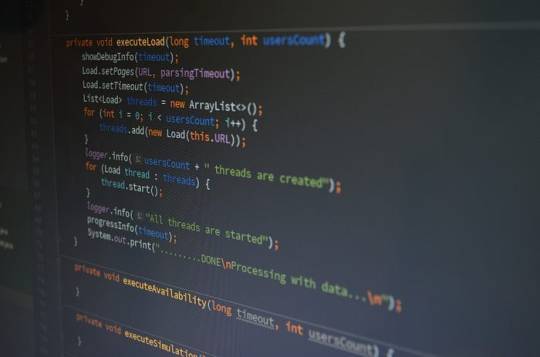
2. Swift

3. SQL
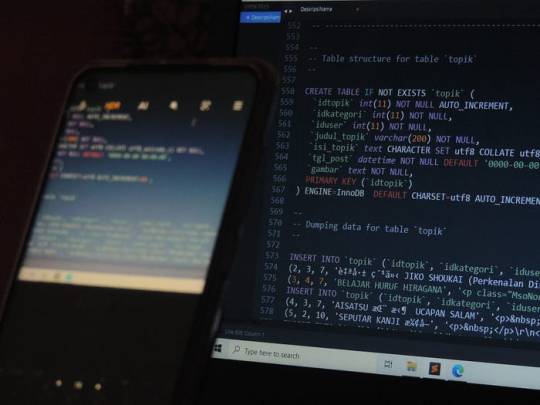
4. JavaScript
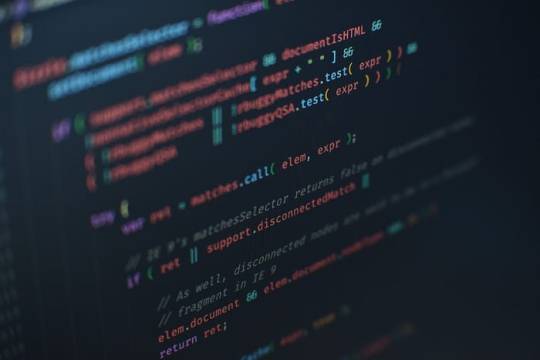
5. Python

The amazing thing about Python is that it’s a general-purpose programming language used to build a wide range of applications. Furthermore, it is active in artificial intelligence. Self-driving cars, Wal-Mart auto-payment, and many automation and machine learning (ML) apps were developed through Python. This makes this language more important and rapidly popularizes. In addition, Python is easier to learn than all other languages and is easy for beginners. You can also build complex applications relatively easily and quickly. In the United States, the average salary for Python developers is about $ 78,000, while experienced developers can be as high as $ 122,000.
2 notes
·
View notes
Text
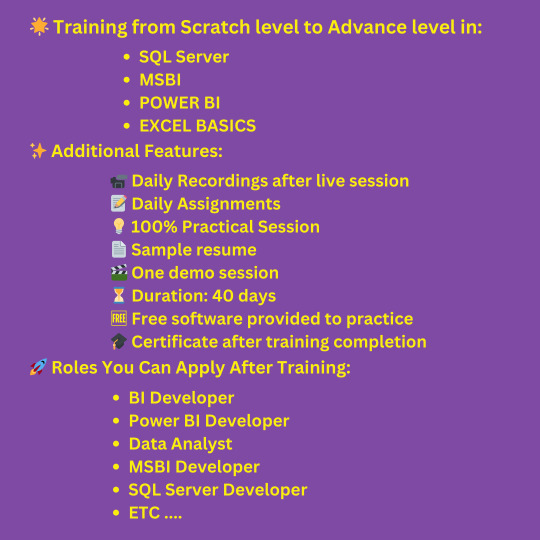
data analyst training courses | online certification courses
Empower your journey with Online IT Solutions. Access top-notch, professional training courses online, and earn certifications for a brighter future.
data analyst online course for beginners , data analyst certification course , data analyst training courses | online certification courses ,data analyst course for beginners , data analyst training | data analyst course
#data analyst online course for beginners#data analyst certification course#data analyst training courses | online certification courses#data analyst course for beginners#data analyst training | data analyst course#data analytics#power bi certification cost#power bi certification#sql#power bi course#power bi course fees#education#power bi#msbi#power bi online training
1 note
·
View note
Text
tagged by @dykekakashi thank you!!!!
fav color: teal/turquoise probably, but I like a lot of colors!
last song: High School Never Ends by Bowling for Soup
last tv show: Mad Men, probably my fave show of all time, I'm on like my millionth rewatch rn lmao
sweet/spicy/savory: all of them, food is my life, but if I had to pick probably savory
relationship status: single
last thing i googled: "does cherry emoji mean boobs" (boomer ass emoji meaning knowledge smgdh)
last thing i read: MS SQL Server beginner's guide on w3schools
current obsession: my usual Star Wars bullshit interspersed with learning code and practicing reading tarot without a book lmao
something i’m looking forward to: not gonna lie, making and eating a fuckton of pesto-sundried tomato pasta later tonight
tagging @insertmeaningfulusername @kanskje-kaffe @withercrown @bokatan @chocobothis @frogunderarock and anyone who sees this and wants to do it! Also of course no pressure if I tagged you and don't want to lol
13 notes
·
View notes
Text
🚀 Master the Art of Programming with Learn24x! 💻
Are you ready to unlock a future in tech? Start your journey today with our expert-led programming courses, designed to take you from beginner to pro in no time!
🎯 Why Choose Us?
Live, interactive sessions with industry experts
Real-world projects to boost your resume
Flexible learning schedule
98% discount on selected courses!
✨ BONUS: Free career guidance and mentoring from professionals working in top MNCs!
⏳ Enroll Now and Claim Your Discount! 🔗 Visit www.learn24x.com 📞 Contact us at +91 80962 66265 for more details.
#LearnToCode #ProgrammingCourses #CareerBoost #TechSkills #FreeGuidance #Learn24x #FutureReady #SQL #FullStack #DigitalMarketing #OnlineLearning #TechJourney
#online courses#edutech#career guidance#learn24x#education#online teaching#coding#career growth#coding skills#ai
2 notes
·
View notes
Text
Best of Web Development Courses: A Comprehensive Guide
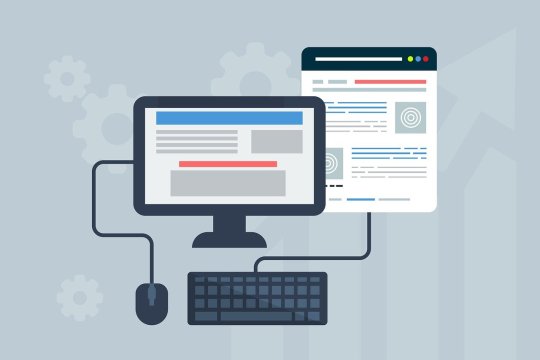
Web development is a vital skill in today’s digital world. Whether you're aspiring to become a professional web developer or looking to enhance your skills, selecting the right web development course is crucial. With countless options available, it can be overwhelming to know where to start. This article provides a guide to the best web development courses available, helping you navigate through the top choices and find the one that suits your needs.
Why Take a Web Development Course?
Web development encompasses everything from creating basic websites to complex applications. The demand for skilled web developers is consistently high as businesses transition to digital platforms. By taking a web development course, you can:
Enhance your coding skills: Learn programming languages like HTML, CSS, JavaScript, and more.
Gain practical experience: Hands-on projects help you build a portfolio to showcase your skills.
Stay updated with industry trends: Modern courses keep you informed on the latest technologies and best practices.
Open career opportunities: Web development is a versatile field with various career paths such as front-end, back-end, or full-stack development.
Now, let’s dive into the top 10 web development courses that will give you the edge you need.
Top 10 Web Development Courses
The Web Developer Bootcamp – UdemyOverview: This course, created by Colt Steele, is one of the most popular web development bootcamps available. It covers everything from HTML, CSS, and JavaScript to more advanced topics like Node.js and Express.Why it stands out:
Over 63 hours of content.
Project-based learning with real-world applications.
Affordable pricing with regular discounts.
Ideal for: Beginners looking to get an in-depth introduction to web development.
Full-Stack Web Development with React – Coursera (offered by Hong Kong University of Science and Technology)Overview: This course focuses on the MERN stack (MongoDB, Express, React, Node). It's offered through Coursera by the Hong Kong University of Science and Technology, which gives it a reputable edge.Why it stands out:
Covers both front-end (React) and back-end development.
Offers a certificate from a prestigious institution.
Focuses on responsive web design.
Ideal for: Learners who want to focus on full-stack web development.
The Odin ProjectOverview: The Odin Project is a free, open-source curriculum that takes you through the entire web development process. It focuses on Ruby on Rails, JavaScript, and offers plenty of hands-on projects.Why it stands out:
Completely free with a community of learners.
Comprehensive learning paths from beginner to advanced.
Emphasizes practical projects.
Ideal for: Self-motivated learners looking for a free, community-driven option.
CS50’s Web Programming with Python and JavaScript – edX (Harvard University)Overview: CS50 is Harvard’s famous computer science course, and this specific track focuses on web programming. You’ll learn about Python, Django, JavaScript, and SQL through this rigorous program.Why it stands out:
Offered by Harvard University.
Covers complex web development topics such as Django and security.
Highly challenging, suitable for intermediate to advanced learners.
Ideal for: Developers with some background looking to dive deeper into web programming.
Complete Web Development Bootcamp – Udemy (Dr. Angela Yu)Overview: Dr. Angela Yu’s bootcamp is highly rated on Udemy for its engaging teaching style and comprehensive approach. You’ll learn HTML, CSS, JavaScript, Node.js, React, and even a little bit of web design.Why it stands out:
Over 55 hours of content.
Fun and engaging style with a focus on building projects.
Regularly updated to reflect the latest technologies.
Ideal for: Beginners who want to build a solid foundation in web development.
Responsive Web Design – freeCodeCampOverview: FreeCodeCamp is known for offering free, self-paced coding lessons, and its Responsive Web Design certification is one of the most popular. You’ll learn HTML5, CSS3, and responsive design principles.Why it stands out:
Free and self-paced.
300 hours of content including hands-on projects.
Community support and real-world project building.
Ideal for: Those looking for a free, structured way to learn responsive web design.
Zero to Mastery Complete Web Developer – Udemy (Andrei Neagoie)Overview: Andrei Neagoie’s course takes a hands-on approach to web development, covering everything from HTML and CSS to advanced topics like React and Node.js.Why it stands out:
Covers both front-end and back-end development.
Real-world projects like building a chat application.
Regularly updated to reflect industry changes.
Ideal for: Beginners to intermediate learners looking for comprehensive training.
Modern React with Redux – Udemy (Stephen Grider)Overview: React is one of the most in-demand front-end technologies today, and Stephen Grider’s course is perfect for those looking to specialize in it. This course covers React and Redux, focusing on building dynamic web applications.Why it stands out:
Specialized focus on React and Redux.
Project-based learning.
Great for intermediate learners.
Ideal for: Developers looking to specialize in React.
Learn Web Development – Mozilla Developer NetworkOverview: MDN’s web development course is a comprehensive, free resource that covers all aspects of web development. It’s created by the Mozilla Developer Network, known for its high-quality documentation.Why it stands out:
Free and constantly updated.
Covers the basics to advanced topics.
Reliable and well-documented resources.
Ideal for: Learners who prefer self-paced study with extensive documentation.
JavaScript, HTML, and CSS for Web Developers – Coursera (Johns Hopkins University)
Overview: This course, offered through Coursera by Johns Hopkins University, focuses on the fundamentals of JavaScript, HTML, and CSS, which are essential building blocks for any web developer.
Why it stands out:
Covers core web technologies.
Earn a certificate from a well-known university.
Focus on building real-world projects.
Ideal for: Beginners looking to get certified in web development fundamentals.
What to Look for in a Web Development Course
When choosing the best web development course for your needs, consider the following:
Skill Level: Are you a beginner or do you have some coding experience? Courses like The Odin Project and freeCodeCamp are great for beginners, while more advanced developers might prefer CS50’s Web Programming or Modern React with Redux.
Specialization: Do you want to focus on front-end (HTML, CSS, JavaScript), back-end (Node.js, Django), or full-stack development? Choose a course based on your career goals.
Project-Based Learning: A good web development course should include hands-on projects to help you apply what you've learned. The more projects, the better your portfolio will look to potential employers.
Certification: If you’re looking for recognition, consider courses that offer certificates from reputable institutions, like those from Coursera or edX.
Price: While some courses are free, others may require a one-time fee or subscription. Many platforms like Udemy offer discounts, so be sure to check regularly.
Final Thoughts
Whether you're just starting your journey in web development or looking to advance your skills, there’s a course out there for you. The best web development courses offer a blend of hands-on projects, updated content, and engaging instruction. As you consider the top 10 web development courses, think about your current skill level, your career aspirations, and your learning preferences. With the right course, you’ll be well on your way to becoming a proficient web developer.
Remember, learning web development is a marathon, not a sprint. Choose a course that fits your pace, stay consistent, and you'll see significant improvement in no time!
2 notes
·
View notes